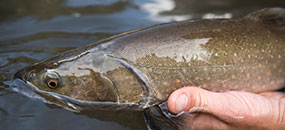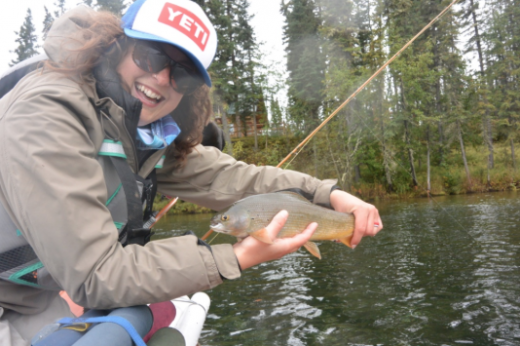By Eric Booton
Frustration is exhaled from behind my fully zipped collar, and the cloud of vapor fills the drawn hood of my wading jacket, fogging my lenses, furthering the frustration. I’ve heard nothing but positive reviews of this impressively clear and painfully cold spring creek. With an exception or two, I was easily able to round up some friends to make the journey for a weekend float on new water. It’s a brisk 40 degrees and raining in the interior of Alaska. The river is quiet and Arctic grayling are taking to the skies upstream, downstream and directly in front of me. Previous experience tells me this should be easy fishing, but it isn’t.
Grayling are famed for their top water takes and not generally regarded as picky eaters. In fact, the first grayling that I caught six years ago was a true testament to the (generally) unpicky nature of the species. Still a novice fly angler at the time and in need of some dry flies for a lake featuring Arctic grayling, I salvaged the hook from a fly that had seen better days and made my first attempt at tying a fly. After sorting through my shedding dog’s trailings for fur with color tones and thickness akin to other flies in my box, I secured the fur to the hook with thread from my sewing kit and a series of hopeful knots. Rudimentary? Very. But much to my delight, it worked.
Griffiths Gnat, Elk-hair Caddis, mosquito patterns, Royal Wulff, various stimulators ... my trusted grayling patterns simply weren’t producing. I had nearly exhausted all the options in my fly box and my lack of experience in having to truly “match the hatch” was shining. Fortunately, my friend Sam from was joining us from Colorado and his more diverse dry fly selection saved the day as we narrowed in on the fly du jour: Blue-winged Olives, and there were only a small handful to go around.
The river flows at a leisurely pace. The water clarity is outstanding and offers up a full preview of the world below. we marveled at the fact that we could see every rock, log and distinguishing feature of the river bed from the vantage point of our raft. Pods of notably large grayling were easy to spot, holding water and taking turns rising from the deep to dine on the next offering of current. These fish got a good, long look at what was hatching on the water’s surface and I couldn’t help but suspect this had to be the distinguished difference between the persnickety diners and the indiscriminate dry fly destroyers I am accustomed to encountering on other waters.
Floating new water and deciphering new fisheries are particularly fulfilling aspects of fishing and the challenge of this new river made for technical treat and more memorable trip. Each fish that made it to hand was all the sweeter.
I intend to add Blue-winged Olives to my tying repertoire this winter to be better prepared, though I suspect next time I visit this river a different fly will be on the menu.
Eric Booton is the sportsmen's outreach coordinator for TU's Alaska Program. He lives and works in Anchorage.




